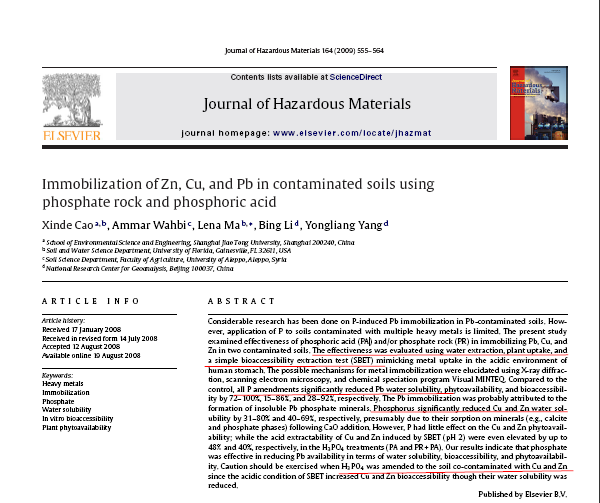Immobilization of Zn, Cu, and Pb in contaminated soils using phosphate rock and phosphoric acid
2017-11-27
Xinde Cao, AmmarWahbi, Lena Ma, Bing Li, Yongliang Yang
abstract
Considerable research has been done on P-induced Pb immobilization in Pb-contaminated soils. However, application of P to soils contaminated with multiple heavy metals is limited. The present study examined effectiveness of phosphoric acid (PA) and/or phosphate rock (PR) in immobilizing Pb, Cu, and Zn in two contaminated soils. The effectiveness was evaluated using water extraction, plant uptake, and a simple bioaccessibility extraction test (SBET) mimicking metal uptake in the acidic environment of human stomach. The possible mechanisms formetal immobilization were elucidated using X-ray diffraction, scanning electron microscopy, and chemical speciation program Visual MINTEQ. Compared to the control, all P amendments significantly reduced Pb water solubility, phytoavailability, and bioaccessibility by 72–100%, 15–86%, and 28–92%, respectively. The Pb immobilization was probably attributed to the formation of insoluble Pb phosphate minerals. Phosphorus significantly reduced Cu and Zn water solubility by 31–80% and 40–69%, respectively, presumably due to their sorption on minerals (e.g., calcite and phosphate phases) following CaO addition. However, P had little effect on the Cu and Zn phytoavailability; while the acid extractability of Cu and Zn induced by SBET (pH 2) were even elevated by up to 48% and 40%, respectively, in the H3PO4 treatments (PA and PR + PA). Our results indicate that phosphate was effective in reducing Pb availability in terms of water solubility, bioaccessibility, and phytoavailability. Caution should be exercised when H3PO4 was amended to the soil co-contaminated with Cu and Zn since the acidic condition of SBET increased Cu and Zn bioaccessibility though their water solubility was reduced.
Published by Elsevier B.V.
